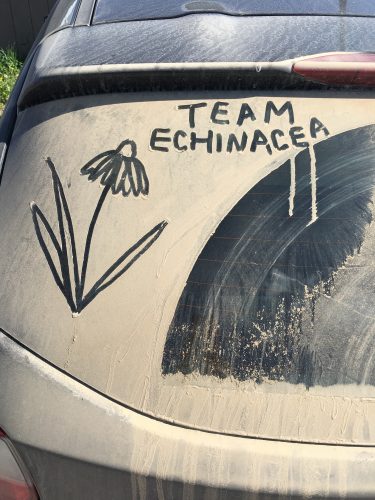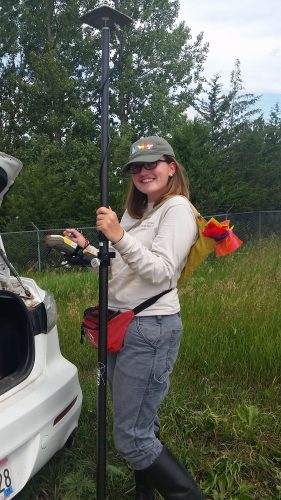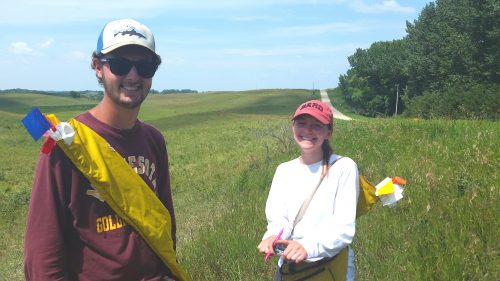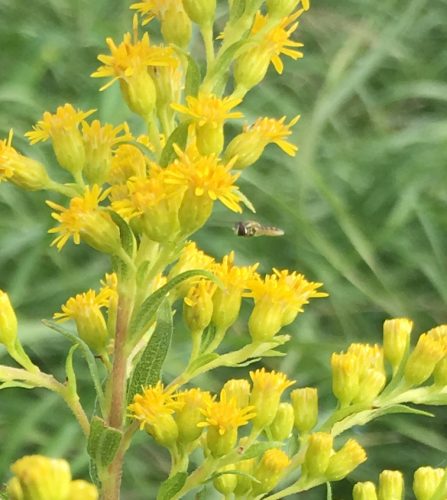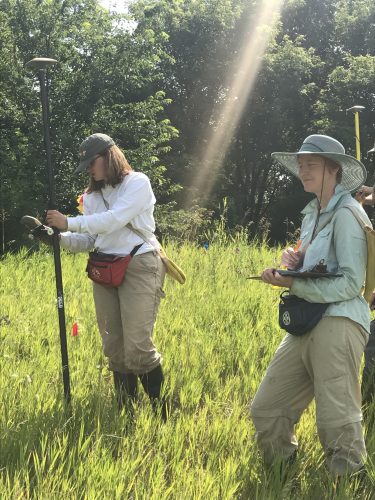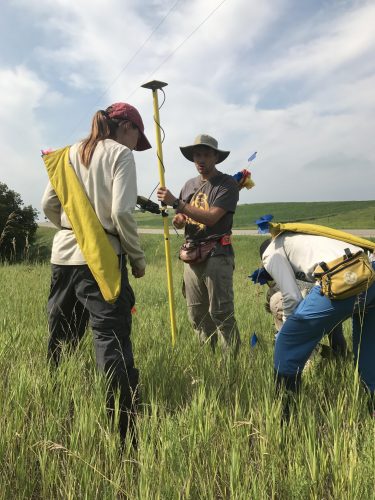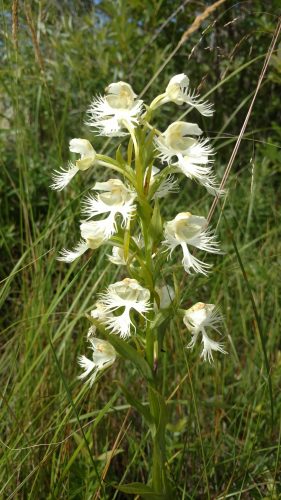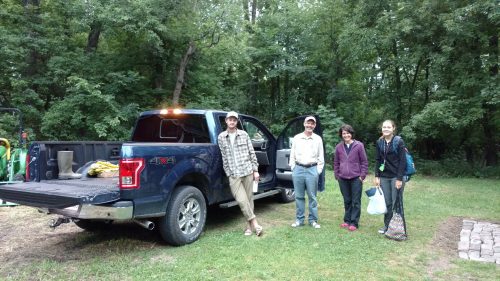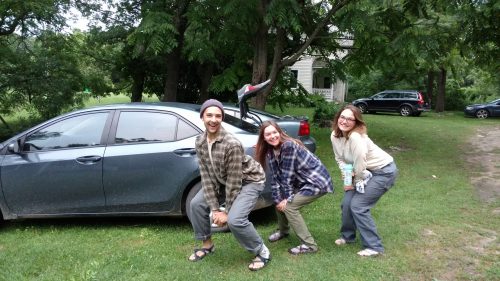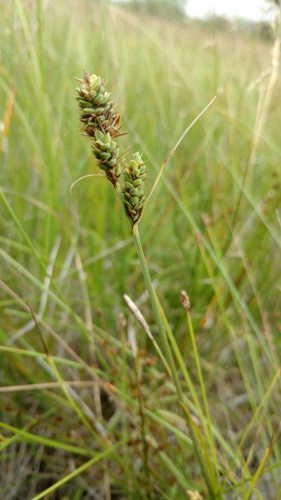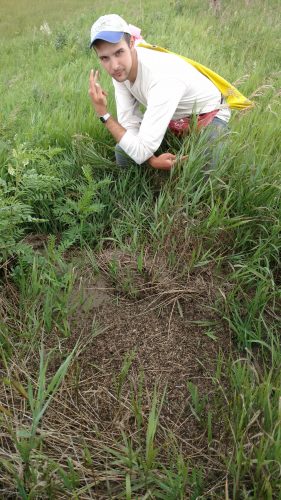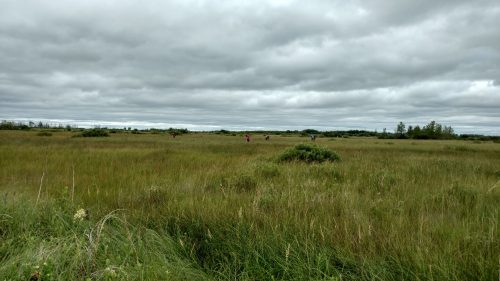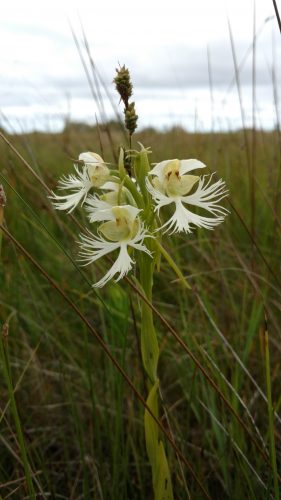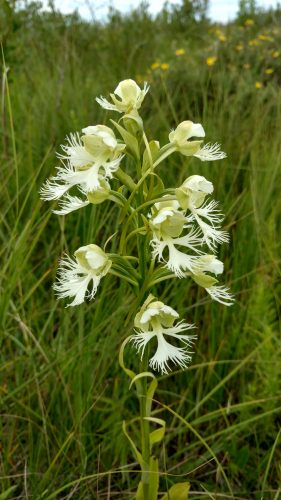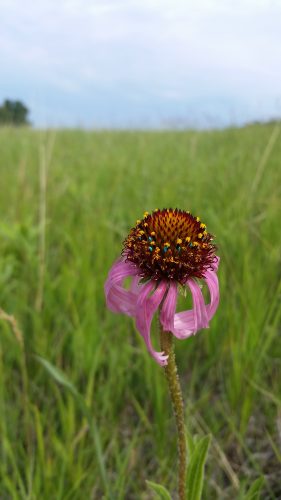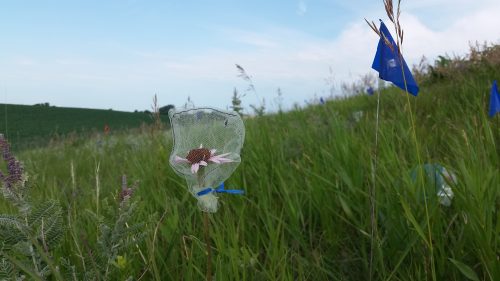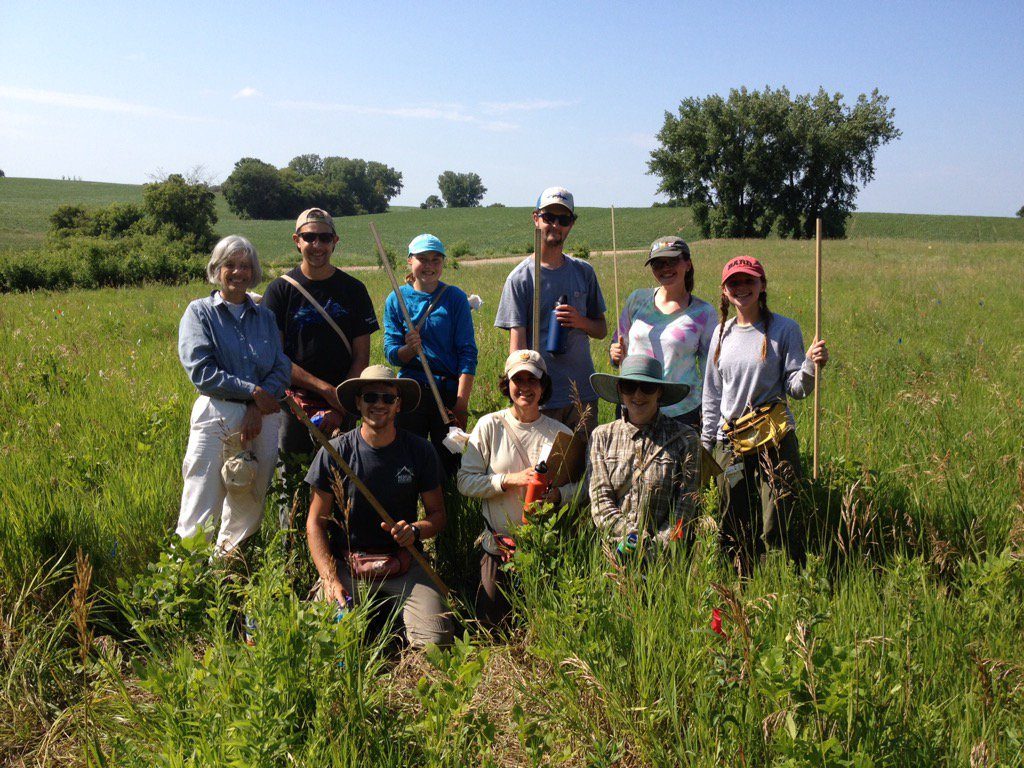|
|
This summer, I’ve been working on an experiment examining style age, pollination treatment, and row position. For future members of Team Echinacea, I wanted to share my data with them. 🙂
To this post, I’ve attached two .csv files. “HeadData_081017” includes data applicable to each head as a unit, and “RowData_081017” includes data applicable to each row. I’ve also attached a .txt file titled “PlantRowShrivelData_MetaData_081017,” which gives an overview of my experiment and explains each column in my .csv files.
.csv files:
HeadData_081017
RowData_081017
.txt file:
PlantRowShrivelData_MetaData_081017
To read the .csv files, copy this script into R:
HeadData<-read.csv(url("https://echinaceaproject.org/wp-content/uploads/2017/08/HeadData_081017.csv"))
RowData<-read.csv(url("https://echinaceaproject.org/wp-content/uploads/2017/08/RowData_081017.csv"))
What phenology means to you (in 5 words or less):
“16/10 first day, great job!”
-Wesley Braker
“Around Landfill, Monarch caterpillars”
-[possibly Anna Vold]
“one two zero one seven”
-Alexander Hajek
“Never red, white, and clear.”
-William Reed
“I’ll do the Nessman loop”
-Lea Richardson
“That’s a nice Echinacea”
-Tracie Hayes
“Let’s check the decision tree!”
-A. Barto
“This one’s not twist-tied!”
-Gretel Kiefer
“Active searching, turn your head”
-[likely Stuart]
Today was a great day. We worked on phenology and independent projects in the morning. At lunch we talked about plans for the week and heard all about Anna’s Waterama victory as First Princess!!! We thought she deserved to be the queen, but alas, 1st princess is pretty good also! After lunch it was a long afternoon measuring in p1. After a few hours, we are almost done measuring in p1. Only a few more rows to go! Until next flog…
 Monarda at Staffanson is beautiful!
The usual activites of Team Echinacea (or at least for the non-locals) on a Sunday are driving in to Alex to do laundry and get groceries for the week. Most of us did that today, but Lea and I also had a special errand to run: Menard’s. We needed to pick up some quadrat-building material. We are beginning a new project this week that has been in planning for some time. We have selected 100 Echinacea plants that have flowered either in 2014, 2015, or 2016, and also have seed set data associated with them at least one of those years. Then, we are going to stake to those plants and do vegetation surveys in a 2 meter by 2 meter quadrat around them. Our goal is to assess whether the diversity surrounding an Echinacea benefits its reproductive fitness. More to come later!
So, Lea and I met at Menard’s to pick out some nice PVC pipe and corner fittings. We got the PVC pipe cut to 2 meter pieces so that everything could fit in our cars. Assembly will take place soon, once we start working in the field! There are some plants at Staffanson first up on our list; I’m sure there will be some exciting species surrounding them.
It was a pretty productive Sunday. Also, here is an update on how dirty my car has become over the last couple weeks:
 Tracie’s car and some advertisement.
Team Echinacea started the morning off with a brief meeting. Stuart reminded us of all of the neat things we’ve done since the field season commenced in mid June, and I must agree, we have done a lot! We have measured all of p8; we’re nearing the end of phenology; we’ve added and excluded hundreds of aphids; and we’ve just begun total demography. Not to forget the smaller individual projects we’ve undertaken, we took a moment to give a very short update on some of our projects’ progress. Our morning meeting transitioned to a new topic as we stalled, so some of the dew in p8 could evaporate: Anna is competing for the title of Queen of Waterama this weekend, and we shared our support for her and enthusiasm for the event. I’m excited to spend Saturday in Minnewaska!
Soon enough, we embarked on our morning task: assessing fitness in p1. I worked with Tracie, and we had fun while crawling through the rows and spotting Echinacea. We switched between recording and measuring, so we never got tired of either task. Tracie was the real star though: Towards noon, she coordinated Anna and I measuring, and she didn’t lose her place once in the Visor! Speaking from experience, that was a feat.
Over lunch, we talked about Waterama a bit more, and our conversation somehow evolved to include hitchhiking. After a few fun anecdotes and many bouts of laughter, we decided on our afternoon objectives. On his way to set out pan traps, Alex dropped me off at Nice Island to count shriveling rates on one of my plants. As I walked from the approach to my plants, I waved to Anna and Wes as they drove to Steven’s Approach to do demography. Then 10 minutes later, Will and Tracie picked me up to do demography at Around Landfill.
 Ready for PBORY! As I set up the GPS, Will, Tracie, and I decided I am standing Queen PBORY, as I love to stake with the GPS and therefore use PBORY frequently. We staked about 35 plants before the GPS went to float, and it remained on float for a solid 30 minutes. I walked as far away from the power lines and the electric fence to minimize interference, and that put me in the middle of the road. I was cautious of traffic flow as I waited for the GPS to return to fixed. After re-configuring the modem multiple times, we restarted the GPS and we were able to stake again–Crisis averted. Eventually, we finished the first portion of Around Landfill, and we picked up Wes and Gretel on our way back to the Hjelm House.
 Will and Tracie love PBORY, even when the GPS is floating We left a bit earlier than usual, so we could eat and get ready for our evening activity–Game night!
 Will, Tracie, and Alex ready to start a fun game of Pandemic! We started the evening off with some refreshing iced tea, and we selected the board games we wanted to play. I chose to play Pandemic with Alex, Tracie, and Will, and Wes, Gretel, Stuart, and Per started a game of Ticket to Ride. Soon, Amy and other members of her research team joined us at game night, and they joined in on Ticket to Ride just as our game got started.
While we played, we shared fun conversations, and even through times of disease outbreak, we kept our cool, and played our cards right. At one point, however, it seemed like the game was over, and the diseases were going to win. After an ice cream and rice crispy break however, we were reinvigorated to defeat the diseases and win the game. As Alex airlifted Tracie across continents, Will quarantined diseases in the East, and I stopped cascading outbreaks in their tracks in the South, we slowly but surely saved the fictional world of Pandemic from doom and won the game.
Overall, and especially after saving the world, I would call today a success (and a lot of fun)!
Today we found plants, measured plants, counted plants, identified plants, pollinated plants, painted plants, examined plants, surveyed plants, and added aphids to plants. A usual day for Team Echinacea. I started out my morning at Lea’s roadside plots to get the weekly update on floral resources. Most of the plants I came across were non-natives, but there was one flowering monarda at one plot and some solidagos at another.
 Flower fly and a Solidago canadensis.
Later in the morning we started total demo at Steven’s Approach. The percentage complete might indicate the steep learning curve most of us are discovering. I’m sure we will get faster with practice.
After lunch we headed out to p1 to measure the 99 garden. It didn’t take too long, and then we had more individual project time! Gretel helped me identify a few plants I was unsure of, and I got the maps for phenology ready for tomorrow. Alex worked on his pollinator identification, Wes and Anna worked on aphids, Ashley entered data from her time at Nice Island today, and Stuart and Will prepared for total demo. A good Tuesday.
 Wes, Blue, Gretel, Anna, and Ashley working in the Hjelm House.
“I love PBORY” – exclaimed Lea as we headed out to learn the total demo protocol. PBORY is the acronym for the order we place flags at the locations of plants that we collect demographic data at. First a gps operator finds the plants using coordinates from previous years, they then place a flag at the location. The color of said flag is dictated by the number of the location they are at. If the location number ends in 1 the the operator puts down a pink flag, a 2 gets a blue flag, 3 gets orange, 4 gets red, and 5 gets yellow, hence PBORY. The acronym helps the team keep the locations straight and get the correct demographic info for each location. The demographers follow the gps operator and collect info at each of the locations.
All of the data we are collecting contributes to the over 20 year long demographic census of Echinacea angustifolia. Some plants have been alive the entire time!
Today we did total demo at our “south of golf course” remnant population which is new to much of the team since we are not collecting phenological data from that population.
We found lots of plants that were still alive from 10 or more years ago, some were even completely surrounded by poison ivy.
 “I love PBORY”  Wes , Tracie, Anna, and Gretel do Total Demo at South of Golf Course
Today was Scott Nordstrom’s last day working at the Chicago Botanic Garden with the Echinacea Project. Scott completed a 13-month internship, during which he worked in the field in Minnesota, assessed lifetime fitness of Stipa plants in our common garden experiment, improved a workflow for taking x-ray images of Echinacea fruits, contributed to analysis and management of numerous long-term experiments, supervised citizen scientists in the lab, and made many other valuable contributions. It was great to have him on the team. This fall, Scott starts a PhD program at the University of Colorado in Boulder. Best wishes, Scott!

Gretel has a fantastic research project where she studies the resilience of Western Prairie Fringed Orchid, a federally endangered wet-prairie species.
 Western Prairie Fringed Orchid We got up early in the morning to drive to the site and there were clearly different levels of excitement. The group in the truck had a normal attitude for 6 in the morning…
 The truck crew ready to leave. …but the crew from Andes was ready to partay!
 The Andes Crew is even more ready. When we got to the orchid site, the weather was cold and looked like rain might threaten our day. We went out to the first plots and learned how to identify orchids, count the flowers, and GPS-mark their location. Then we split up into two groups and systematically went through the orchid plots.
 Stuart and Anna searching for orchids We came across a ton of orchids! Anna was enthusiastic in her finding.
 Anna found an orchid! Then we marked each orchid with a flag so they can easily be found in the fall when fruit count surveys are done.
 We marked each orchid with a flag with an identifying number. Besides seeing hundreds of orchids, we also saw many thousands of black-eyed susans (Rudbeckia hirta) and flowering sedges.
 Rudbeckia hirta in full bloom.  A flowering sedge.  More flowering sedges! There was also a beautiful ant hill.
 Alex and a massive ant hill.  The wet prairie of Pembina.  An orchid in it’s natural habitat.  One of the biggest orchids we found. Until next time!
Wes
Happy Tuesday, Flog readers!
Team Echinacea took the morning to work on personal projects, so I hitched a ride to my experimental site, Nice Island. There, I collected pollen and made notes about what my plants were up to. Since I’m examining each row of Echinacea florets under different pollen treatments, I am generally quite careful to note strange things. Today, I noticed one of my plants had styles that were wilted and discolored, another had a severely tilted receptacle, and another was turning crispy–Yikes! I talked to Stuart, and I will remove those from my experiment later this week. Bummer. 🙁
 One of my experimental plants after I painted R5! Fortunately, the ones that are becoming obviously unfit for my experiment are few and far between, and I’m finding more suitable candidates.
I spent most of my time this morning bagging capitula, pollinating styles, and painting bracts to denote rows. It’s a detailed-oriented task, no doubt, but it has required me to channel my inner artist to meticulously paint the small bracts. I really enjoy doing it too. I can put on some music, sing along, and paint at the tempo of the song. It’s great.
When I counted, pollinated, and painted all that I needed to for the day, I started back on my walk to the Hjelm House. To my surprise, Ruth met me at Nice Island, and I happily showed her what I was up to, and she asked some key questions about my project. She also showed me a magnifying visor I can wear while I do my crosses, and I think it will be very useful in the future, so I can be sure I am using enough pollen on each style.
 One of my experimental plants with a pollinator exclusion bag. When Ruth and I returned, I had about an hour before lunch to organize my data from the day. I’ve created a colorful spreadsheet to remind me of what color each row is painted and when each head needs to be pollinated. As I count shriveled styles in my steady pollination treatment and enter that data, my spreadsheet updates the percent of shriveled styles–a key metric for my experiment. I like how my experiment is shaping up!
When lunch came, I enjoyed my egg, hummus, and apple meal while the team talked about rating Echinacea and why Team Pallida isn’t quite the antihero to Team Angustifolia. Pleasant conversation, for sure. When lunch wrapped up, Ruth shared some tasty almond chocolate with all of us, and we marveled at the Romeo & Juliet excerpt on one chocolate’s wrapper and the Bubo bubo information on the other’s wrapper.
In our post-chocolate contentedness, Ruth talked to us about the Echinacea fitness experiment in p1, Gretel talked to us about the protocol for measuring that fitness. After our introduction to the experiment, we booted up (although some chose to tough it out in sandals), and headed out to p1. We measured for a couple hours, and by the time we wrapped up our field time for the day, we were nearly 2/3 done with that experiment’s measurement!
 The team after an afternoon of measuring in p1 When the Andes crew returned to our summer home, we removed our ticks and battled mosquitoes. For dinner, I made artichoke and spinach stuffed shells and a salad from the lettuce in our weekly CSA. Yum yum!
Now, I’m going to try to plan out a pollination schedule, so I can try to go on the orchid trip Thursday.
Until next time,
Ashley
|
|


